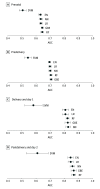Predictive Modeling for Perinatal Mortality in Resource-Limited Settings
- PMID: 33206194
- PMCID: PMC7675108
- DOI: 10.1001/jamanetworkopen.2020.26750
Predictive Modeling for Perinatal Mortality in Resource-Limited Settings
Abstract
Importance: The overwhelming majority of fetal and neonatal deaths occur in low- and middle-income countries. Fetal and neonatal risk assessment tools may be useful to predict the risk of death.
Objective: To develop risk prediction models for intrapartum stillbirth and neonatal death.
Design, setting, and participants: This cohort study used data from the Eunice Kennedy Shriver National Institute of Child Health and Human Development Global Network for Women's and Children's Health Research population-based vital registry, including clinical sites in South Asia (India and Pakistan), Africa (Democratic Republic of Congo, Zambia, and Kenya), and Latin America (Guatemala). A total of 502 648 pregnancies were prospectively enrolled in the registry.
Exposures: Risk factors were added sequentially into the data set in 4 scenarios: (1) prenatal, (2) predelivery, (3) delivery and day 1, and (4) postdelivery through day 2.
Main outcomes and measures: Data sets were randomly divided into 10 groups of 3 analysis data sets including training (60%), test (20%), and validation (20%). Conventional and advanced machine learning modeling techniques were applied to assess predictive abilities using area under the curve (AUC) for intrapartum stillbirth and neonatal mortality.
Results: All prenatal and predelivery models had predictive accuracy for both intrapartum stillbirth and neonatal mortality with AUC values 0.71 or less. Five of 6 models for neonatal mortality based on delivery/day 1 and postdelivery/day 2 had increased predictive accuracy with AUC values greater than 0.80. Birth weight was the most important predictor for neonatal death in both postdelivery scenarios with independent predictive ability with AUC values of 0.78 and 0.76, respectively. The addition of 4 other top predictors increased AUC to 0.83 and 0.87 for the postdelivery scenarios, respectively.
Conclusions and relevance: Models based on prenatal or predelivery data had predictive accuracy for intrapartum stillbirths and neonatal mortality of AUC values 0.71 or less. Models that incorporated delivery data had good predictive accuracy for risk of neonatal mortality. Birth weight was the most important predictor for neonatal mortality.
Conflict of interest statement
Figures



References
-
- Levels and trends in child mortality. UN Inter-agency Group for Child Mortality Estimation. Published 2018. Accessed September 1, 2020. https://data.unicef.org/wp-content/uploads/2018/10/Child-Mortality-Repor...
Publication types
MeSH terms
Grants and funding
- UG1 HD076461/HD/NICHD NIH HHS/United States
- UG1 HD078439/HD/NICHD NIH HHS/United States
- UG1 HD076465/HD/NICHD NIH HHS/United States
- U01 HD040477/HD/NICHD NIH HHS/United States
- U10 HD078439/HD/NICHD NIH HHS/United States
- U10 HD076457/HD/NICHD NIH HHS/United States
- U10 HD076474/HD/NICHD NIH HHS/United States
- U01 HD040636/HD/NICHD NIH HHS/United States
- U10 HD076465/HD/NICHD NIH HHS/United States
- U10 HD078438/HD/NICHD NIH HHS/United States
- UG1 HD078438/HD/NICHD NIH HHS/United States
- UG1 HD076457/HD/NICHD NIH HHS/United States
- UG1 HD076474/HD/NICHD NIH HHS/United States
- U10 HD076461/HD/NICHD NIH HHS/United States
- U10 HD078437/HD/NICHD NIH HHS/United States
LinkOut - more resources
Full Text Sources
Medical

